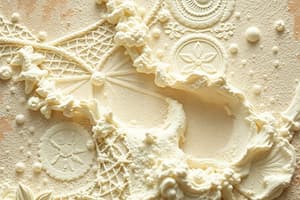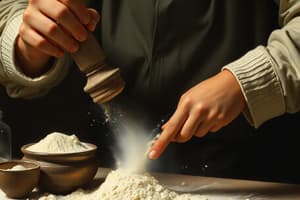Podcast
Questions and Answers
"Match!" software primarily utilizes what type of data for phase identification?
"Match!" software primarily utilizes what type of data for phase identification?
- Powder Diffraction (correct)
- UV-Vis Spectroscopy
- Mass Spectrometry
- X-ray Fluorescence
Which of the following is NOT a primary purpose of using "Match!" software?
Which of the following is NOT a primary purpose of using "Match!" software?
- Performing qualitative and quantitative analyses
- Predicting novel crystal structures (correct)
- Matching diffraction patterns against a database
- Simplifying complex calculations
Which of the following is a significant advantage of using "Match!" software for powder diffraction analysis?
Which of the following is a significant advantage of using "Match!" software for powder diffraction analysis?
- It provides limited options for adjusting parameters.
- It requires extensive manual data processing.
- It offers rapid comparison against reference databases. (correct)
- It is limited to analyzing only a single, specific file format.
A materials scientist is using "Match!" software but finds that some advanced databases required for their specific analysis are not included in the standard package. This scenario highlights which disadvantage of the software?
A materials scientist is using "Match!" software but finds that some advanced databases required for their specific analysis are not included in the standard package. This scenario highlights which disadvantage of the software?
A researcher needs to perform a detailed analysis of powder diffraction data, including Rietveld refinement, but is using an older version of "Match!" software. Which upgrade benefit would be most relevant to this researcher?
A researcher needs to perform a detailed analysis of powder diffraction data, including Rietveld refinement, but is using an older version of "Match!" software. Which upgrade benefit would be most relevant to this researcher?
A lab technician is tasked with analyzing a very large dataset of powder diffraction patterns. Which potential disadvantage of "Match!" software should they be most aware of?
A lab technician is tasked with analyzing a very large dataset of powder diffraction patterns. Which potential disadvantage of "Match!" software should they be most aware of?
What is the most significant difference between version 3 and version 4 of the Match! software?
What is the most significant difference between version 3 and version 4 of the Match! software?
Which of the followings is a disadvantage of the Match! software?
Which of the followings is a disadvantage of the Match! software?
Flashcards
Match! Software
Match! Software
A software tool that identifies phases in a sample by comparing its powder diffraction pattern to a database of known compounds.
Qualitative Analysis (Match!)
Qualitative Analysis (Match!)
Using diffraction patterns to determine the components present in a sample.
Quantitative Analysis (Match!)
Quantitative Analysis (Match!)
Measuring the amounts of different components present in a sample using diffraction patterns.
Purpose of Match! Software
Purpose of Match! Software
Signup and view all the flashcards
Advantages of Match! Software
Advantages of Match! Software
Signup and view all the flashcards
Disadvantages of Match! Software
Disadvantages of Match! Software
Signup and view all the flashcards
Improvements in Match! v4
Improvements in Match! v4
Signup and view all the flashcards
Rietveld Refinement
Rietveld Refinement
Signup and view all the flashcards
Study Notes
- Match! is a software tool designed for analyzing powder diffraction data.
- It identifies phases in unknown samples by comparing their diffraction patterns with a database of known compounds.
- Match! performs qualitative analysis to determine which phases are present.
- It is capable of quantitative analysis to measure the amounts of present phases.
Purpose of Match! Software
- It identifies phases in a sample using powder diffraction data.
- Match! compares diffraction patterns against a database of reference patterns.
- Qualitative and quantitative analyses, including Rietveld refinement, can be conducted.
- It simplifies calculations for easier use.
- Match! aids researchers and scientists in material characterization and analysis.
Analyzing Phases
- The best matching phases are presented, enabling the selection of desired phases for matching.
- Once a phase is chosen, it automatically appears in the match list.
- All phases present in the sample can be viewed in the match list.
- A semi-quantitative analysis is performed, estimating the quantities of phases in the sample.
Advantages of Match! Software
- It features a simple interface for beginners.
- Quick Data Matching: Compares your data with reference databases rapidly.
- Adjustable Settings: Users can change options for better results.
- Saves time by automatically finding patterns through automation.
- Supports multiple file formats.
- Strong Data Tools that promote data accuracy.
- Easy Reporting to simply export of results for sharing.
- Offers great features at a lower price than others and is therefore affordable.
Disadvantages
- Some advanced databases require extra payment due to limited free access.
- While easy to use, understanding complex data might need high skills and some knowledge.
- It is specifically designed for science and technology fields and is thus, not for everyone.
- Can lag with huge datasets due to being slow with big data.
- New versions might require more payments as updates may cost extra.
- Additional tools like FullProf are required for some features, meaning you would need extra software.
Version 4:
- Version 4 has a more user-friendly design than version 3, providing a better interface.
- It includes a larger and newer reference database due to it's updated database.
- Faster Performance: Version 4 runs faster and handles large data more efficiently.
- It includes improved Rietveld refinement and new analysis tools, which are extra features.
- Version 4 fixes bugs from version 3 for better stability due to fixed issues.
- Supports additional file types and tools compared to version 3, thereby providing more compatibility.
Recommendation on Using Match!
- Regular Use is great for frequent powder diffraction work in research.
- In-Depth Analysis is ideal for complex tasks like phase identification.
- Database Access is helpful for comparing your data with large reference databases.
Studying That Suits You
Use AI to generate personalized quizzes and flashcards to suit your learning preferences.
Related Documents
Description
Match! is a software tool used for analyzing powder diffraction data. It identifies phases in unknown samples by comparing diffraction patterns with known compounds. The software is capable of both qualitative and quantitative analyses, aiding researchers in material characterization.





